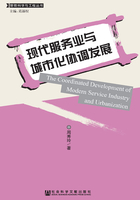
Abstract
This book starts from the formation theory and development theory of modern service industry and urbanization,and then puts forward the coordinated development problem of them,which is based on the theoretical foundation of the relationship between modern service industry and urbanization and combined with the corresponding relationship of the evolution of industrial structure and urbanization stage. Through the analytic hierarchy process and factor analysis,this book measures the level of the modern service industry and urbanization of 31 regions in our country,and through variable coefficient model,it has an empirical analysis of the relationship and degree between them. By combing the development of modern service industry and urbanization in some representative countries of the developed countries,emerging industrialized countries and developing countries and understanding the interaction relationship between them,it can provide reference of the coordinated development of modern service industry and urbanization in China. Then this book analyzes the problem of coordinated development of modern service industry and urbanization in China. Finally,some policy recommendations to promote the coordinated development of modern service industry and urbanization are proposed under the comprehensive consideration of theoretical analysis,lessons from foreign countries and the existing problems in China.
In this book,the measure results of the level modern service industry and urbanization of 31 regions show that the high level of urbanization areas,its level of modern service industry is relatively high and a large difference exists among the regional level. For example,Beijing and Shanghai have obvious advantages of development,driving up the national average. In some coastal areas,such as Tianjin,Guangdong and Zhejiang,the development level of modern service industry and urbanization is relatively good,and the development level of the central and western regions is below the national average with backward urbanization and low level of development of modern service industry. The regional difference of modern service industry is larger than that of urbanization. The correlation analysis of the modern service industry and urbanization shows that there is a long-term and stable equilibrium relationship and the degree of the role of urbanization on modern service industry varies from the development level of different areas,the developed areas have highest degree,and second is underdeveloped areas and the less developed areas are the lowest.
Through the analysis of the relationship of the coordinated development of the modern service industry and urbanization in China,this book summarizes the affects of following factors about the coordinated development between them:the household registration system,the economic system and other institutional factors hinder the coordinated development of modern service industry and urbanization;the problems like urbanization lagged behind in industrialization,the low level of urbanization,imbalance in regional development,the lack of scientific in urban planning and others restrict the service industry,especially the development of modern service industry. In turn,currently the low level of China’s service industry,the slow upgrade of the internal structure,and the inadequate proportion of modern service industry hamper the promoting of urbanization. In response to these problems,this book proposes the following policy recommendations:improve the household registration system and social security system to provide an institutional indemnification for the development of urbanization and modern services;strengthen market-oriented reform and technological innovation to provide power for its development;give full play to the guiding role of the government to provide policy support;accelerate the urban economy and the development of industrial clusters,and reduce the gap between the degree of regional development;emphasize the training and introduction of talents to provide the follow-up forces of urbanization and modern service industry and so on.